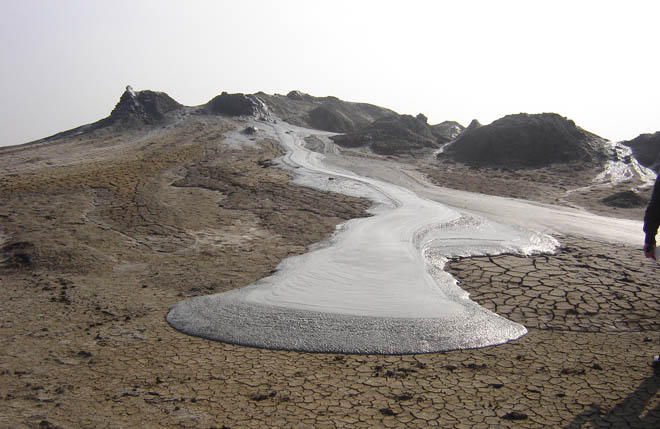Over 400 volcanic eruptions recorded

By Laman Ismayilova
Volcanoes are spectacular forces of nature. The have long been a source of myths and legends. A volcanic eruption is a unique and beautiful sight.
The first mud volcano eruption in Azerbaijan was recorded in 1810 in the Caspian Sea.
Over the past 200 years, 418 eruptions have been recorded in 93 mud volcanoes in Azerbaijan.
The head of the department of mud volcanism at the Institute of Geology and Geophysics, doctor of geological-mineralogical sciences, professor Adil Aliyev told Trend.
He noted that there are 353 volcanoes in Azerbaijan, 200 of which are on the surface. About 60 percent of them do not erupt at all.
"As a result of the eruption, the microforms of volcanic crater, gas, water, dirt are released without affecting the Earth’s surface. In areas where this process is active, the volcano does not erupt, because the energy is already exhausted. In rare cases, erosion happens when some volcanoes are very weak. For example, the volcano Shikarpar in Gobustan erupts every 2-3 years," said Aliyev.
The professor stressed that volcanoes in Binagadi, Lokbatan, Shamakhi and Gobustan erupt very often. Other volcanoes erupt within 5–10 years, and sometimes 25 years later.
Azerbaijan or as it is called Land of Fire has the highest number of mud volcanoes in the world. Some 350 out of over 1,000 mud volcanoes in the world are located here.
The world’s largest mud volcanoes - Boyuk Khanizadagh and Turaghai - are both in Azerbaijan. Boyuk Khanizadagh, the diameter and height of which are 10 kilometers and 700 meters respectively, erupted on October 10, 2001, shooting out flames for 300 meters in the air. It was the highest record for flames shot from a mud volcano.
Underground and submarine mud volcanoes are also located in Azerbaijan.
There are more than 140 submarine volcanoes in the Caspian Sea. Eight islands in the Baku Archipelago are mud volcanoes by origination.
About 23 mud volcanoes in Azerbaijan received the status of the National Park and are protected by the state. In addition, they were included in the list of Seven Wonders of the World.
There are several interesting facts about mud volcanoes in Azerbaijan.
NASA geologists studying Mars planet, concluded that mud volcanoes of Azerbaijan are similar to uplands of the planet for their structure.
On September 5, 2004 the greatest mud volcano in the territory of Azerbaijan was added into the Guinness World Records.
The mud volcanoes located in Gobustan National Park sights attract thousands of tourists annually.
The State Historical-Artistic Reserve has been functioning since 1967. In 2007, the reserve was included in the UNESCO World Heritage Sites list.
A trip to Gobustan gives you a great chance to see these amazing active volcanoes from very close distance.
Azerbaijan's rich fields of oil and gas condensate such as Lokbatan, Garadagh, Oil Rocks, and Mishovdag were also discovered near mud volcanoes.
The lava, mud, and liquid spewed by mud volcanoes are used as raw materials for chemical and construction industries, as well as pharmacology.
Enriched with specific components - mineral salts, organic substances, microelements, volcanic mud has medicinal properties that have a beneficial effect on the human body.
Volcanic mud gives a great effect in the treatment of patients suffering from diseases of the peripheral and central nervous system, gastrointestinal tract, skin, etc.
---
Laman Ismayilova is AzerNews’ staff journalist, follow her on Twitter: @Lam_Ismayilova
Follow us on Twitter @AzerNewsAz
Here we are to serve you with news right now. It does not cost much, but worth your attention.
Choose to support open, independent, quality journalism and subscribe on a monthly basis.
By subscribing to our online newspaper, you can have full digital access to all news, analysis, and much more.
You can also follow AzerNEWS on Twitter @AzerNewsAz or Facebook @AzerNewsNewspaper
Thank you!
